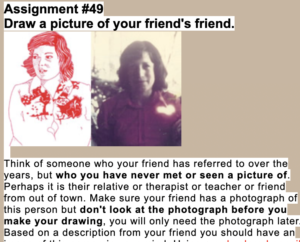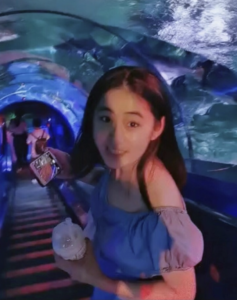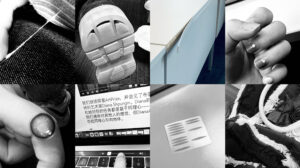Art Assignment
1
I choose the assignment: Learning to Love You More.
(Available at: http://learningtoloveyoumore.com/reports/12/12.php )
The activities are no longer available for some reason, so I write them as follows.
Create a topic :
Take a photo of the toothpaste (Morning or evening).
Use any materials just as pigment and any color to imitate the shape of toothpaste. Draw on the paper, and write a short sentence under this blob of paint.
Take a close-up picture of the painting. Send this along with your name, location, and the name of the material.
I got a totally wrong understanding of the assignment before, so I choose a new one below.
Assignment #49
Draw a picture of your friend’s friend.

This is what I drew.


2
@theArtAssignment
https://theartassignmentresponses.tumblr.com/tagged/Embarrassing%20Object
“Embarrassing object”
I chose to showcase something that makes me feel embarrassed in my today’s life.
1. The stray thread on the clothing.
2. Broken shoe sole.
3. Come unglued the table margin.
4. Unevenness manicure.
5. The sudden falling cosmetic contact lenses.
6. A video of the sound was accidentally released.
7. The double eyelid stickers on the desk.
8. Distorted bag.

Reflective Analysis
Aims/Objectives: It’s an open and interesting form through media that encourage every particular form of art and creativity. And it’s show attempt to challenge the authorship of the art market(Helguera, 2011), which could affect the social sphere in a meaningful way.
Mechanics: In my opinion, the activity may need more interaction with the participator. More communication and understanding between individuals can bring deep and lasting influence on the art assignment and culture(Helguera, 2011). For example, the public can take continuous creative forms such as relaying each other.
Timing: For some easy assignments, I could complete them in about 20~15 mins.
Prep: As for some of the Assignments, they do need extensive preparation. For example, which requires us to collect materials or make exhibitions. Situations are different if we choose some work that can be completed by sentences or simple paintings.
Learners: (Problem Scenario) I agree with the assignment “avoid making assumptions about the learners that will use”. That kind of art assignment was defined as socially engaged art activities(Helguera, 2011), they try to engage the public across different disciplines even different languages to satisfy the system of open art.
I have been just been commissioned to create an Artist’s Toolkit that is a comprehensive open educational resource (OER). I’ve been advised that I should avoid making assumptions about the learners that will use this Toolkit. Since I will only be paid when I complete the commission, I have very few resources at my disposal. How might I achieve this task?
Reflection
During these two weeks, we continue working with the group by researching and designing our assignments. In this sprint, we focus on two concepts open and toolkit.
Firstly, based on a problem scenario, We had a task about creating an Artist’s Toolkit which is a comprehensive open educational resource. In our basho, we share ideas about how to understand the two concepts and discuss what is an open toolkit.
From a paragogy perspective, students central (learner-centered) teaching is more flexible and beneficial for learning. Paragogy is a kind of peer-to-peer and decentred learning. In the short term, peer and cooperation learning is more conducive to knowledge exchange. For example, in today’s digital generation, learners studying together is similar to exposure to social media, which armed them with new pieces of information. In long term, this way of the class is like some non-linear knowledge construction, encouraging a collaborative curriculum, which may have a positive effect through co-creating. As Here (2013) said, paragogy learning may better prepare learners with the skills needed for lifelong learning via personal learning networks, which promote connectivity and creativity among students.
Secondly, I get a deeper understanding of open learning from doing the art assignment. Fletcher and July’s Learning to Love You More was a crowdsourced art project, which asks ordinary people to contribute to assignments posted on the site and features responses that are surprising, touching, imaginative, and often hilarious.
From a constructivist perspective, Learning to Love You More is essential to today’s constructive learning. Through their social interactions and experiences, constructivists continuously look into and criticize how we scaffold learning, which could be viewed as scaffolding that promotes specific kinds of “subjectivization.” It is a useful form to facilitate learner who is not passive recipient of knowledge, they are more to construct the knowledge themselves. Learning is a lasting changed state (emotional, mental, physiological) brought about as a result of experiences and interactions with content or other people, just like organizational activity Creating, preserving, and utilizing information flow(Siemens 2005). These art forms give individual learners freedom and encourage their development and ideas as individuals. As Stuart Brand famously said, “information wants to be free”. So does learning. Constructivists constantly emphasize the necessity of technology and connection for learning in the digital era. Learning to Love You More reduces the limitations caused by traditional communication, taking advantage of websites to build open learning and interactions.
In conclusion, After these studies and realizations, I not only know about many of the learning theories but also, found that in one group system, one behavior always affects another, it is more helpful to make accurate care plans and reviews for assessing research when doing tasks together. What’s more, reflection is a useful process, it helps us to make records and learn from our experiences.
Reference
Helguera, P. (2011). Socially engaged art. New York: Jorge Pinto Book. 3-7
Herie, M. (2013). Andragogy 2.0? Teaching and Learning in the Global Classroom: Heutagogy and Paragogy. Global Citizen Digest, 2(2): 8-14.
Siemens, G. (2005). Connectivism: A learning theory for the digital age. International Journal of Instructional Technology & Distance Learning, 2, 1-10.
Learning to Love You More.
(Available at: http://learningtoloveyoumore.com/reports/12/12.php )


23rd October 2022 at 7:34 pm
The author’s writing style is worthy of my learning and reference, she has formed a system of their own, the art of openness to put the different parts of each of us together through our imagination to collaborate to collide more exciting, group cooperation to promote each of us mutual aid and creativity to develop our teamwork skills, will be of lifelong use to us. Learning to love you more is not only physically or psychologically a process of breaking through the traditional consciousness of the self, thanks to the author’s blog gave me great inspiration.
24th October 2022 at 12:50 am
Awesome blog!I love your review of the art assignment Learning to Love You More.I can sense that your experience is deep and that you have used constructivism to analysis it.This is really great.Perhaps you could talk more about some of the parts of constructing the OER?Looking forward to seeing more of your insights.
23rd November 2022 at 1:11 pm
Misty, the description here of your responses to the two assignments you picked in class works well (nice drawing!) You follow this up with critical reflection that seems to relate to both – it’s not entirely clear. It would make sense to edit this so that you discuss one assignment, then analyse it, then the second. Looking at the mechanics is really the best approach to take here. Stick with this method.
23rd November 2022 at 1:15 pm
The second part of your post – “Reflection During these two weeks…” is also well structured. It’s a good approach to take this kind of overview. You do a good job of outlining paragogy here, but not so good with Constructivism. It looks like you are actually describing Connectivism (Siemens is a Connectivist). I think you should edit this part of your post and revise it accordingly as, as it stands, it is not an accurate account of Constructivism.